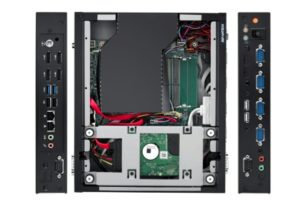The AMD ‘Zen’ microarchitecture and its embedded ecosystem of AMD Ryzen Embedded V1000/R1000 processors sets a new standard in processing power for next-generation embedded designs.
Advantech offers these ultra scalable SoCs on rugged Mini-ITX motherboards. They are tailored for the needs of graphics-intensive markets requiring 24/7 operation in embedded systems and connected edge devices.
With the AMD Ryzen Embedded V1000 processors, AMD gives embedded system engineers real flagship APU performance to design state-of-the-art embedded edge computers for all industries relying on stunning graphics. These SoC solutions seamlessly integrate the ‘Zen’ CPU and ‘Vega’ GPU architectures, combining up to 3.61 TFLOPS discrete-GPU caliber graphics with ultimate computing performance. Overall improvements include an IPC uplift of 52% on the CPU and throughput/clock improvements of 200% on the GPU compared to predecessor platforms, as well as a competitive price edge over alternative options.
Typical markets for AMD Ryzen Embedded
With this impressive performance, the processors are perfect candidates for next-gen devices in the medical imaging, industrial vision inspection, video surveillance and logistic vehicle sectors requiring situational awareness. And of course, they are also great for the multitude of applications with an entertainment factor, such as professional broadcasting equipment, digital signage players and professional gaming systems, as well as industrial HMIs, visualization computers in central SCADA control rooms and simulation equipment.

The AMD Ryzen Embedded R1000 rounds off the ecosystem of pin compatible BGA processors towards more cost efficient platforms, while offering everything that makes the pioneering “Zen” CPU and “Vega” GPU architectures highly attractive. Namely, it brings multi-threaded performance to the low power sector of R-series designs for the first time. With 3x generational performance improvement per watt, and 4x better CPU and graphics performance per dollar than the competition[iii], the R1000 is an ideal fit for the more price sensitive embedded applications. As the R1000 SoCs between 12W and 25W are platform compatible with the Ryzen Embedded V1000 series, they enable system designers to offer a very broad range of applications with a single platform design.
Pin compatibility makes for ultra scalability
Embedded computing vendors are utilizing the pin compatibility of both performance classes, V1000 and R1000, to make their new platforms ultra scalable. For example, the performance of Advantech’s rugged AIMB-228 Thin Mini-ITX motherboards is scalable from 2.4GHz-3.3GHz AMD Ryzen™ Embedded R1505G with Radeon™ Vega 3 graphics, 2 cores/4 threads and a TDP of 12-25W, to 3.35GHz-3.8GHz Ryzen™ Embedded V1807B with Radeon™ RX Vega 11 graphics, 4 cores/8 threads and a TDP of 35-54W. In terms of performance this means that engineers can scale from 100% of the slowest R1000 variant to approximately 176% of the fastest V1000 version.[iv] As for GPU and GPGPU performance, scalability is even greater. Here, the spectrum ranges from 384[v]GFLOPS for the Ryzen R1505G to the immense processing power of up to 3.66 TFLOPS for the Ryzen V1807B, which means 953% more GFLOPS. This enables perfect balancing of price and performance, tailored to the dedicated application.
GPU for massive parallel processing
These days, GPU performance is also a question of general purpose GPU (GPGPU) utilization for parallel processing of data in vision and/or deep learning applications.

In this respect, the AMD ecosystem convinces with OpenCL as well as ROCm and TensorFlow support with its open-source software foundation for GPU computing on Linux. All the ROCm-specific modifications for TensorFlow are today part of TensorFlow’s master repository, following the same open-source ethos as the entire deep learning community.[vi] To round off the heterogeneous computing options, the AIMB-228 Thin Mini-ITX motherboard further supports field programmable gate array (FPGA) extensions via special PCIe® x1 gold finger connected external FPGA modules, which customers in the gaming industry use for executing game specific algorithms. Other customers may want to use FPGAs for preprocessing of imaging techniques in lidar, sonar or MRT applications. But such support is standard for embedded board vendors and nothing special.
Customization is a feature
Vendors such as Advantech are used to tailoring their embedded motherboards to the needs of OEMs, including BIOS/UEFI adaptations, customized OS images and APIs, along with all required certifications. Other customers may not require all interfaces. In cases where no revision of the PCB is necessary, customization is possible even in low-volume production of a few hundred boards. But custom designs are also an option with larger PCB revisions if appropriate quantities are demanded. This applies, for example, when customers request medical Ethernet connectors or want to also use the 2x 10 Gigabit Ethernet functionality of the processor, which might be of high interest for next-gen Industry 4.0 connected machines with OPC UA and TSN based data exchange in real-time towards ERP and MES systems and adjacent Industry 4.0 machines. Finally, a standard housing of the embedded board also often needs to be tailored towards the OEM device. Embedded is therefore also synonymous with a wide choice of customization options for OEMs.
Rugged by design
Besides customization, the design principles also differ. Embedded Mini-ITX motherboards offer many valuable features that go far beyond standard Mini-ITX motherboards designed for commercial applications.

Operated in well-temperatured, shock and vibration free environments with comfortable humidity levels, such commercial designs are far less sophisticated than their industrial counterparts. Rugged Thin Mini-ITX motherboards rely on soldered processors, stable capacitors and components designed for harsher environments and 24/7 operation. Operational reliability is of utter importance for them. However, really high durability on the embedded level has its price as rugged components are more expensive. But it makes no sense for OEMs to save about 100 Euro with commercial boards, if a system failure produces not only the same costs for the replacement board plus costs for the soldered processor but also massive maintenance service costs – not to talk about end users’ revenue losses due to idle machines during repairs. OEMs and end users simply do not accept productivity losses caused by such IT failures. To be able to deliver efficient product service, they also need identical boards in the same configuration for many years. This is of utter importance, too, for device certifications – namely for the medical device industry, as well as for new mobility applications.
Remote management and monitoring for IoT applications
Finally, the level of IIoT support also differentiates the embedded offers from standard commercial Mini-ITX boards. The Advantech AIMB-228, for example, comes with the IoT device operations and management software WISE-PaaS/DeviceOn. Starting with onboarding devices, the solution’s zero-touch IoT technology seamlessly registers the board with identity, security, and field site settings. The fast and simple setup helps provide instant intelligent edge onboarding, data acquisition, and status visualization at the device operations center. Power on/off, troubleshooting, and mission-critical actions are available at the touch of a button for quick and easy access. OTA software updates itself securely by sending software patches as well as firmware, software and configuration updates through batch provisioning.
Wide-range DC power and abundant I/O connectivity
Finally, let’s have a detailed look at the embedded features of the new boards, which are also available as industrial systems including standard housing along with all required certifications such as EMI and CE to reduce time to market for customers. The AIMB-228 is designed for a wide-range DC power source (DC 12V~24V) that offers the flexibility to fit into customer-specific system designs.

Besides this, the AIMB-228 comes with rich I/O connectivity and multiple high-speed I/Os including: 2 x USB 3.1 Gen2, 4 x USB 2.0, 2 x SATAIII, 1 x internal keyboard/mouse port, 1 x Intrusion Protection, 6 x COM (RS422/485, CCtalk, TTL), PCIe x8, 1 x M.2 B key accompanied with one SIM card holder for easy 3G/LTE module or NVMe storage installation, 1 M.2 E key expansion socket for WiFi module connectivity. Furthermore, the AIMB-228 supports 16-bit digital programmable I/O, dual Gigabit Ethernet ports (Realtek 8111E) delivering up to 1000 Mbps of bandwidth at each port, and one PCIe x1 via gold finger for external FPGA modules.
Four independent displays with up to 4K resolution
The AIMB-228 Mini-ITX motherboard integrates the latest AMD ‘Vega’ GCN (up to 11 CUs), supports high efficiency video coding (HEVC) with 10-bit (4K H.2654 and H.264) decode and 8-bit encode, delivering excellent graphic performance. With four independent displays supported via DisplayPort (DP) 1.2 and the option to use the low voltage differential signaling (LVDS) interfaces, the AIMB-228 also offers many built-in features, such as TTL/CCtalk, 10W amplifier, and the highest level 4 ESD protection, making it ideal for gaming, digital signage, or medical imaging applications which require high graphic performance and operate in noisy or sensitive environments.
[i] https://www.amd.com/en/products/embedded-ryzen-v1000-series [ii] See Video picture, AMD source, picture and caption 2 [iii] EMB-159 and EMB -160: Testing done at AMD Embedded Software Engineering Lab on 3/13/2019. The AMD R1505G Embedded scored 360 running Cinebench R15 Multi-core and 1,988 running 3DMark11 benchmarks. The Intel Core i3-7100U (Kaby Lake) scored 254 running Cinebench R15 Multi-core and 1,444 when running 3DMark11 benchmarks. Recommended customer price for Intel Core i3-7100U is $261 as of 4/1/2019 (check ark.intel.com/content/www/us/en/ark/products/95442/intel-core-i3-7100u-processor-3m-cache-2-40-ghz.html). DBB price for R1505G is $80. System Configurations: AMD Embedded R1505G used a AMD R1000 Platform, with a 2x8GB DDR4-2400 RAM, 250GB SSD Drive (non-rotating), TDP 15W, STAPM Enabled and ECC Disabled, Graphics Driver 18.50_190207a-339028E-AES, BIOS RBB1190B, Microsoft Windows 10 Pro. Intel Core i3-7100u used a HP 15inch Notebook, i3-7100u with Intel® HD Graphics 620, 1x8GB DDR4-2133 RAM, 1 TB 5400 rpm SATA, Microsoft Windows 10 Pro, Graphics Driver 21.20.16.4627, BIOS F.07. [iv] Source of benchmark figures: https://technical.city/en/cpu/Ryzen-Embedded-R1505G
A 76% increase each in passmark and overall benchmark performance was recorded.
[v] https://de.wikipedia.org/wiki/Liste_der_AMD-Ryzen-Prozessoren [vi] Source: https://medium.com/tensorflow/community-supported-amd-rocm-build-for-tensorflow-e8e9ac258369 CIE Components in Electronics
CIE Components in Electronics


